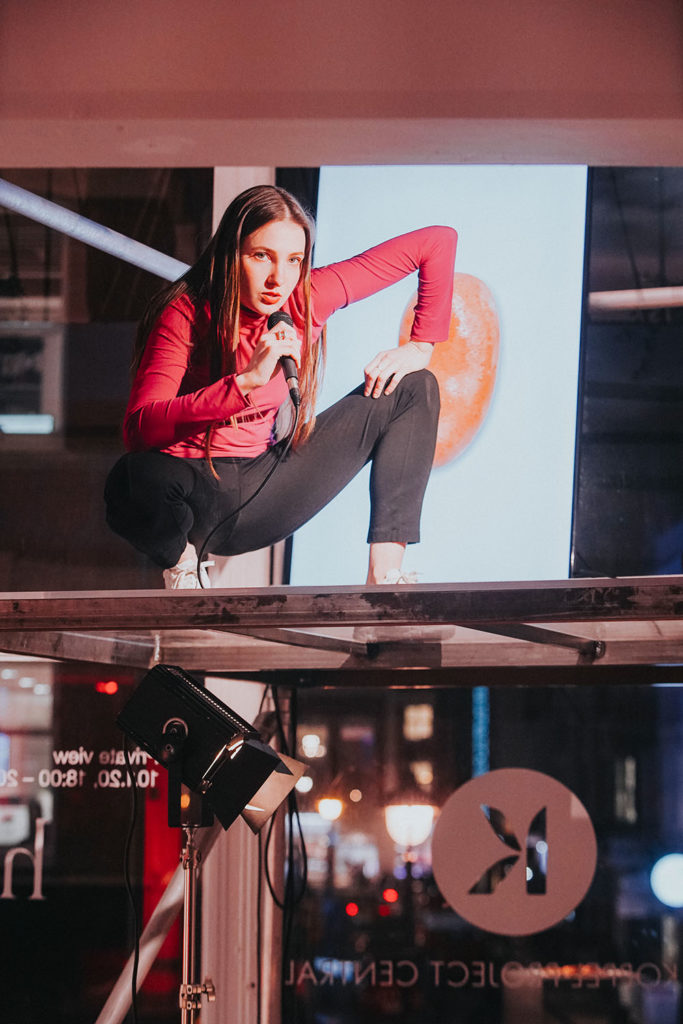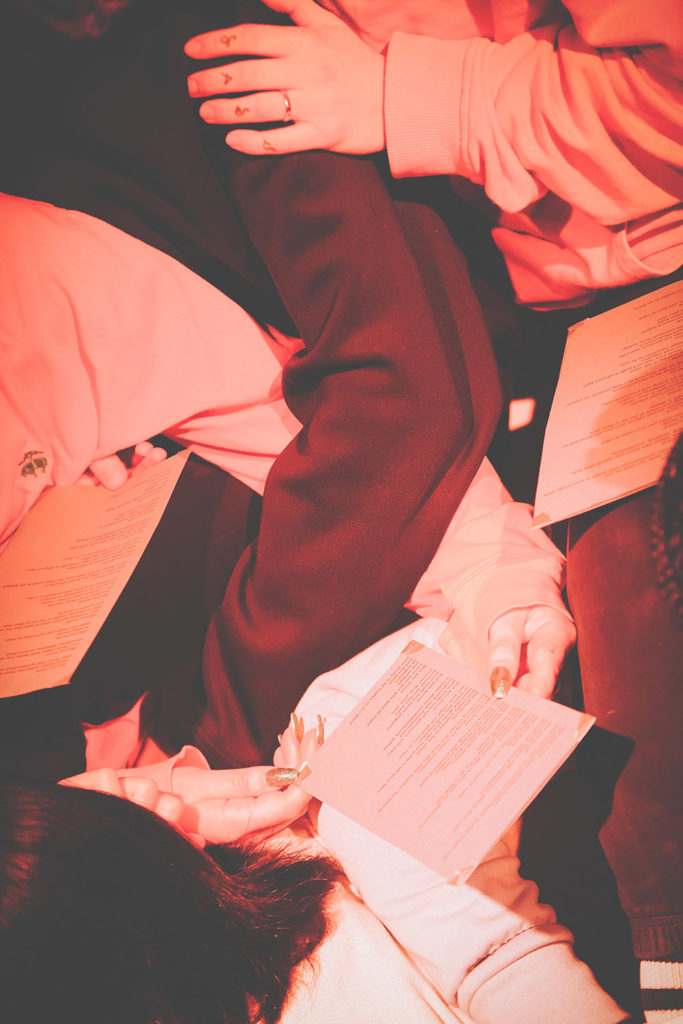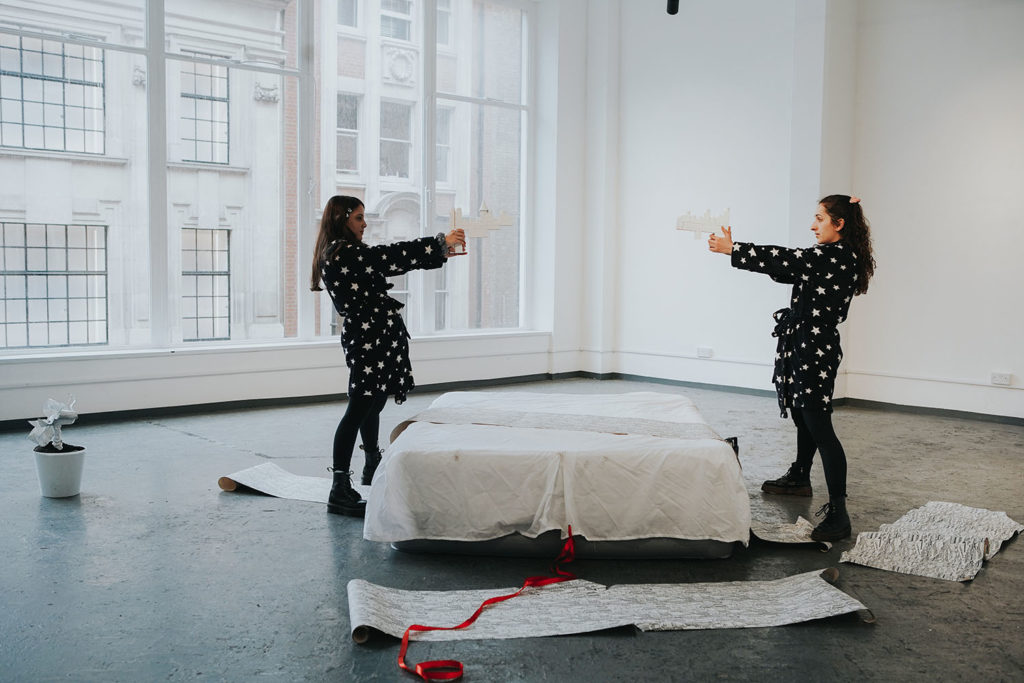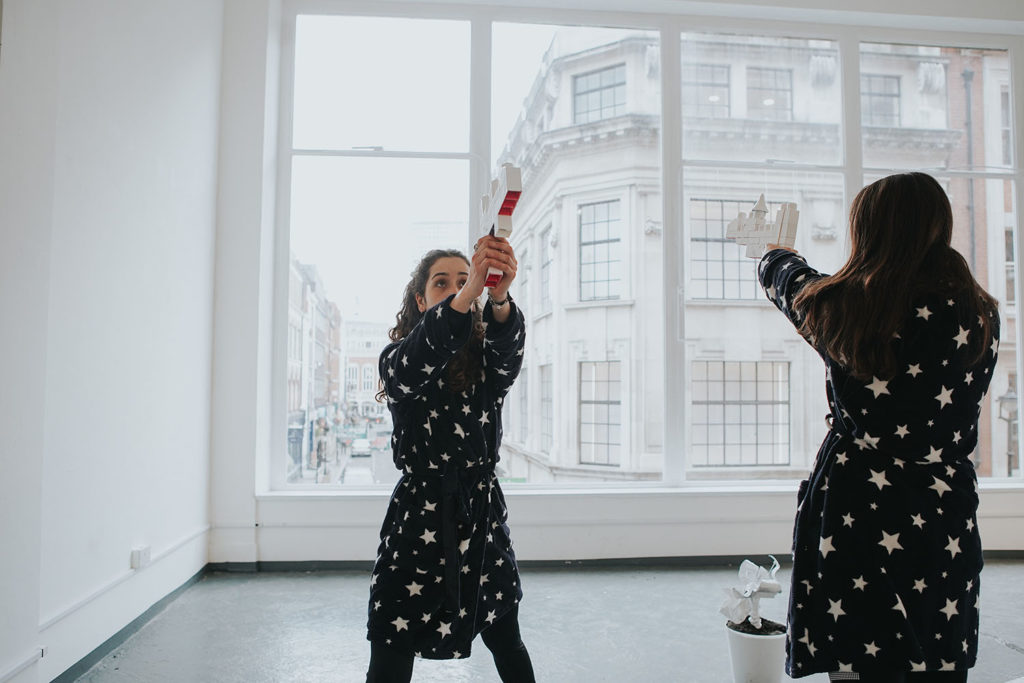[Irene Adorni, Daria Blum, Rowland Hill, Dominic Till, Panicattack Duo, Ruby Wroe]

curated by trans-
at The Koppel Project Central
49-50 Poland Street, London, W1F 7ND
11th January – 22nd February 2020
PV took place on 10th January featuring performances by Daria Blum, Panicattack Duo and Ruby Wroe

did you know_ (2019). Ruby Wroe’s performance during the exhibition opening, 10 Jan 2020 
Hold On, Installation View 
Tha-at’s right (2018), Rowland Hill, Mixed media installation 
CRAWLING TO THE MARGARINE – STOMACHS ARE GOING TO ROLL (2020), Dominic Till, Mixed media installation 
To Bean (2019). Daria Blum’s performance during the exhibition opening, 10 Jan 2020
A project of the trans- curatorial collective, Hold On is both a reflection on the ethics of the encounter and a critique of language, its mediums, and neoliberal strategies of communication. The acceleration of information exchange and the pressures of semiocapitalism constantly force our actions and attitudes into a punishing cycle of productivity, focused on short term stability, not sustainability. How do we envision our future from within this system? How do we channel our energies and desires into nurturing a healthy social body, rather than perpetuating an individualist fantasy?

Aiming to reverse the inherently isolating demands of capitalism, these Generation Y international artists and curators, including Irene Adorni, Daria Blum, Rowland Hill, Dominic Till, Panicattack Duo, Ruby Wroe, explore collaboration as a healing and regenerative process, wherein alternative forms of resistance can flourish. From this specific generational perspective, through the exhibition the viewer was encouraged to join a public dialogue and experience the gaps between the conformation of norms and their reconsideration through various aesthetic, performative, audio, video, and visual interventions in the space.
Hold On explores the uses and impact of language, and the assertions which constitute our social exchanges, by unfolding the artists’ works into emotive and political discourses. Through a number of mediums and approaches, the artists featured in this exhibition investigate what impacts the construction of subjectivity, its cultural value, and its political position within current power structures. When even arts spaces are contaminated by neoliberalism, we wonder if there is a way to negotiate the collective automatisation of our society through our art. Can we embrace ways of suspending the capitalist human condition? Hold On and its associated public programme constituted an open invitation to visitors to question and actively resist the way in which identity, feelings and life expectations are predetermined by unjust socioeconomic systems.
did you know? (2019), Ruby Wroe
‘did you know?’ was born out of a piece of speculative fiction written by the artist, in which the protagonist – a collective being made from multiple bodies, is deciding whether to continue existing physically, or to choose new forms of consciousness now readily available. did you know? wonders what bodily memories we would keep, when we no longer need or have the bodies that generated them.
To Bean (2019), Diara Blum
‘To Bean’ (2019) is the artist’s insistent request for attention: ‘Look at my beans.’ From a tall, welded structure, Daria Blum demands the viewer consider what she has built and admire the tiny objects she has crafted—both form the framework for a performance in which she invites the audience to recognize and indulge in a common need for affirmation.
Daisies (2020), Panicattack Duo
Through ‘Daisies’, Panicattack Duo perform & share their own cultural divination practices. Throughout the sound piece Panicattack is trying to tune in to their female alternatives, whereas the choreographed actions are taking on the anarchistic attitude of film Daisies (1966), playing with exaggerated scenes of embodying excessive greed, spoiledness & the absurdity of our world. Disregarding a typical narrative, characterisation or visual continuity, the duo mirrors their antipathy for traditional social norms.
SNEAK PEEK
[trans- in conversation with the artists, March – May 2020]
The complete Q&A conversation will be contained in the publication of Hold On, which is going to be launched in Autumn 2020. Here, we are offering exclusively on Bloggy just a little taste of what we have been discussed with Dominic, Daria, Irene, Ruby, Naz & Emily, and Rowland.
Hold On project and its publication are supported by Arts Council England.
[DOMINIC TILL]

Dominic (…) I’d like to think that when it was shown at The Koppel Project it clearly negotiated concerns surrounding Brexit, but going forward it will be accessible from a different perspective. Those bread-and-butter issues will always exist, and the UK will always physically be an island. The politics of the day will dictate how the work is interpreted, and not the other way around. That might just be ego talking though, I’m yet to make my mind up. (…) I’ve often said that my work looks at and deals with power structures but maybe it’s more about the former and less about the latter. In short, I’m attempting to create narratives that can be interpreted in multiple ways, and subsequently be open to differing perspectives.
trans- We are experiencing a complex social and economical situation due to the effects of COVID-19. Not everyone has the same privileges and not all governments are taking the accurate measures for everyone to be in a safe position. How do you relate this particular context to your artistic practice and how do you expect this will affect the social class struggle?
Dominic It’s going to be hard for everyone and pretty much every single person globally is going to have to make sacrifices, rich and poor, young and old. I’m not sure really if I have a great deal to say on this because quite frankly it’s shit for all. Without doubt, the poorest people in society will be the ones who are hit the hardest and it should go without saying that those people are going to need the most help. I just hope that it is there for them.
I don’t mean to come across uncaring in this matter because it’s quite the opposite but at this moment in time, I’m not thinking about it in relation to my practice. I’ve sacrificed my studio because I’m not going to be able to afford it but I’ve already made arrangements to move in with friends at a cheaper rate – that makes me fortunate and I’m grateful for that and them. Simply put, it’s not ideal but there are people far worse off than I am. This whole thing is totally unprecedented and so questions about its wider context are hard to answer – I’d be taking a stab in the dark.
[DARIA BLUM]

Daria I started making these [beans] in the fall of last year, when I was readjusting to a new creative environment, people, and situations in my life. Coming from a practice based mainly in performance, video, and music, I was not used to creating physical objects, but moulding clay with my hands proved to be extremely soothing, almost therapeutic. Very often, the making of my work and the personal struggles experience during the process become the content of the final piece in one form or another.
trans- In a moment in which human contact (as we know it) is being disrupted globally, how do you envision the future of performance art and, in consequence, how do you think social interaction and collective care will change?
Daria I still think first about performance in relation to the individual, ‘how do I perform for myself, or when I’m by myself, and how have other people’s expectations been shaping the way I perform?’ Questions of, ‘how do I perform for others in this situation?’ and ‘how do I act, not just with my own, but with everyone’s interests in mind?’ are those which I believe might shape social behaviour in the future.
I hope that more considerate ways of ‘performing’—like caring for our most vulnerable—will be embraced in the future, and that this will extend beyond our immediate community. We should invest time now to cultivate new ways of living, consuming, sharing. Continued vigilance and opposition to the exploitation of crisis for profit, and looming exclusion of the marginalized are even more crucial now. (…)
[IRENE ADORNI]

Irene Monomyth in narratology and comparative mythology is the hero’s journey and it is the common template of a broad category of tales and lore that involves a hero who goes on an adventure , and in a decisive crisis wins a victory , and then comes home changed or transformed. The hero of the work is the viewer, who faces a journey within the installation by going through a place of transit such as the corridor. In that space, people move through different sound sources that attract or push them away and create a network of information. In this entropic space saturated with different voices, rhythms, and sounds the viewer tries to put order and find his own path and meaning, but the contemporary hero can’t overcome the moment of crisis with action and victory (…)
trans- Your piece has bonds with the culture of clubbing and the bodies’ encounter, which is a form of getting together and surviving within this unconditional contemporary incapability of taking decisions. In this very particular historical period of time – which has drastically changed in a month due to COVID-19 – how do you project the concept of bodies’ encounter in relation to this current need of being self-isolated and the global fear and distrust when approaching others physically?
Irene Clubbing, in relation to the work, is represented as a moment in which the research of the acceleration of the body starts from an individual need, but finds a response in the totality of bodies with which the individual is surrounded. (…) I believe that, concerning this concept, the situation created by the Covid-19 emergency may lead us to consider in the first place the difference between the physical and non-physical body in relation to the web, which has already been widely discussed in the past. Does a user on the web have a detachment from the physical body, being present there only with his own consciousness? (…)
[RUBY WROE]

Ruby I think the thoughts behind the work did you know?, came from a desire to fictionalise how a future event might feel. What, besides our jobs, might we be asked to give up or change in the future, and how might this feel? In this instance, the topic was the body. How might it feel, for the first generation who may have the option of ceasing to inhabit a human, fallible body, and what thoughts might this generation have? What might we mourn, and what might we be liberated from? The work recants physical memories, from childhood scrapes and scarred knobbly knees to dancing, sexual encounters, abuse, pleasure and pain. (…)
trans- In the current situation we find ourselves, in which we cannot perform physical daily rituals as we used to do – such as meeting our friends in a pub, hugging people, making love or going to the supermarket normally – how do u think the perception of our individual and collective body is changing?
Ruby I think right now, when the majority of us are social distancing, self isolating, or in quarantine, the need for collectivity is emphasised – because despite physical distance, it’s still happening. People are having drinks with friends virtually, long phone chats, video calls, playing games together online. (…) I guess what happens less online during this time is the chance meeting – when you get chatting to someone after you’ve asked them for a cigarette, or bump into someone you weren’t expecting to see. We have to seek people out now, choose them, but sometimes the most important interactions aren’t the ones you choose to have.
Although a lot of our collective socialising can take place virtually, I just read an article recounting a nurses experience of holding the hands of people as they die. She knows the importance of touch in these moments, and wants her patients to have someone there, when their loved ones can’t be. There is no virtual replacement for these moments.(…)
[PANICATTACK DUO]
[[Naz Balkaya & Emilia Demetriou]]


Nothing Really Mattress (2018) + Daisies (2020), Panicattack Duo 
Nothing Really Mattress (2018) + Daisies (2020), Panicattack Duo
Panicattack Duo Nothing Really Mattress (NRM) is our mobile studio – a double mattress, and it was a manifestation of many probes and matters of concern. Back in 2017, when we came to perceive the mattress as a work in itself, we were struggling with the precariousness that was and still is involved around making performance work in a contemporary art context. Performance became an exhibition opening, private view trend, where performance artists have to be grateful for the ‘spotlight’ or the opportunity to promote their work; but ‘… unfortunately there is no budget left to be able to pay..’ us. We were also very tired of constantly and precariously spending time on excessive and lengthy proposals for funding applications and open calls (which we can now see and have proof that things can be done in a different way; since the pandemic has hit and we’ve been in this emergency state all applications and open calls have adapted to less precarious and easier processes).
In 2017 we had been working collaboratively for 4 years and we never had the chance to rent our own studio after leaving uni, so we always worked on each other’s beds. We knew that the conversations that we exchanged, our research, thoughts and worries -the working process as well as our friendship- had somehow a more meaningful value to be shared. The unseen practice behind our familiar performances, the lack of studio space as well as the time consumed by precariousness was what evoked NRM.
(…) Daisies is a choreographed performance and a sound piece, where we embody our own cultural and ancestral divination practices. Naz has grown up in Istanbul surrounded by women who are nurturing the practice of tasseography (coffee telling) and Emily comes from a line of dream tellers in her Bulgarian family. (…) As contemporary women we have been trained to forget the visceral connections to each other and are bred to an antagonistic way of existence, where convenience, privacy, and mobility are more important. What we want to trigger is the memory of that intuitive sharing, compassion and empathy. (…) Historically outsiders, what can women and their ancestral practices offer us today? What would it be like if the traditional practices of healing, herbalism, midwifery were brought back? What if we listened to the worries of those women about our future? Are there any matriarchal solutions? Through delving into these matters we don’t only want to remind or trigger that mindful awareness but we want to manifest a magnetic field that leads us to artists, researchers and minds that are involved in these conversations. We think there is a lot more to learn and understand, and we are only at the beginning of our retrospection.
trans- Right now, social distancing is an imposed condition due to the global emergency situation of the COVID-19. As a duo, you’ve had to develop your practice in a situation of distance on several occasions, how has it affected your practice and how did you reach collaboration through distance?
Panicattack Duo It is like a cycle, almost: experiencing distance, bonding over that mutual experience, becoming ‘inti-mates’, being able to cope and keep our friendship and practice progress and develop when far apart. Back in 2013, when we first met at Kingston School of Art, the experience of migration and loneliness in a strange land was what brought us together, and how our friendship and collaboration began . Having this indescribable insight of distance from our homes, families and friends was something we shared. For a few years during uni we had the opportunity to cultivate our relationship as friends and collaborators (and the line between them is very blurred, they both exist because of each other). At the same time, being far from home cultivated our perception of distance and the sensibilities needed in place for any kind of relationship to keep alive and healthy. Last but not least, by the end of the 3 years of uni we knew that we want to make our collaboration work forever, even though both our plans were to return back home at some point, so that made it very clear that we have to make distance work.
What are the sensibilities needed in place for a relationship to work from far? Understanding the needs of one other and respecting them; because a lot of the time distance is not enforced like it is now, but it is a result of our needs. I wish/need to travel and explore the world, I wish/need to be with my parents, to have a family, a child, a gap year, an MA or a PhD, a job, a certain career, a separate but parallel path in another field, more collaborators, the examples can keep going. We need to appreciate each other’s intuitions and support them to grow in whatever way they wish and when this is mutual from both sides then it is a blessing to have each other.
[ROWLAND HILL]

Rowland This was the first time that the video piece Tha-at’s right is exhibited together with the original backdrop that appears on the film. The eleven-minutes long video captures the process of choreographing a dance from a review of a dance. This review, written in 1959 by critic and poet Edwin Denby in response to a ballet by Stravinsky, articulates music and movement using an idiosyncratic stream of metaphors. Tha-at’s right takes these outlandish descriptions literally by using them as scripts or scores, translating the written word back into a performance.

Photo credit: Rocio-Chacon

